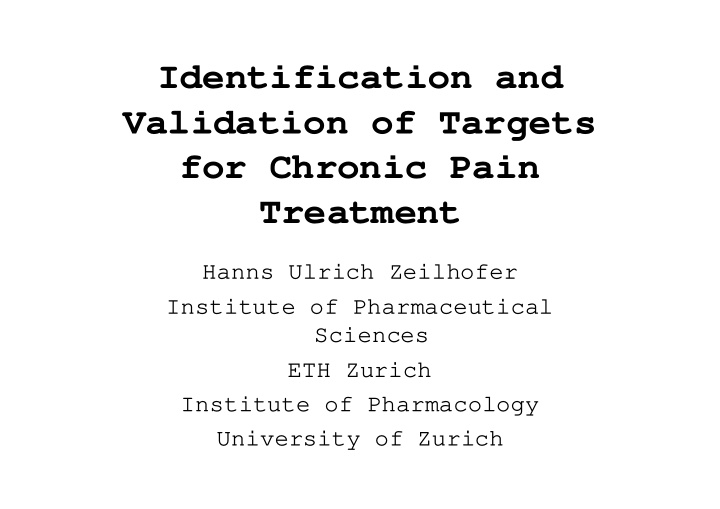



Identification and Validation of Targets for Chronic Pain Treatment Hanns Ulrich Zeilhofer Institute of Pharmaceutical Sciences ETH Zurich Institute of Pharmacology University of Zurich
Prevalence of Chronic Pain 19% of the European population suffer from chronic pain (VAS ≥ 5, range 0 ... 10) 33% of these patients report strong pain (VAS ≥ 8 - 10) In 59% of these patients pain lasted for at least 5 years. * Telephone interviews with 46’392 persons from 15 European countries and from Israel ** longer than 6 months, VAS (0-10): ≥ 5 *** VAS (0-10): 8-10 Breivik et al., Eur J Pain 2006
Satisfaction with Pain Medication Insufficient pain relief Breivik et al., Eur J Pain 2006
Patients Concerns about Pain Medication Breivik et al., Eur J Pain 2006
Examples for Sources of Chronic Pain • Inflammation rheumatoid arthritis • Nerve damage chronic regional pain • Trauma syndrome Zur Anzeige wird der QuickTime™ Dekompressor „TIFF (LZW)“ benötigt. amputation
Acute Pain - Chronic Pain Acute Pain Chronic Pain Evoked by adequate stimuli, e.g. Evoked by in-adequate stimuli mechanical stress hyperalgesia noxious heat allodynia acidosis spontaneous pain Correlates with Outlasts peripheral stimulation intensity and duration of the stimulus (inflammation or tissue repair) Chronic pain is a form of maladaptive CNS plasticity
Peripheral and Central Pain Sensitization secondary (central) hyperalgesia allodynia primary (peripheral) spontaneous pain hyperalgesia
Patch-Clamp Recordings from Neurons in a Transverse Rat Spinal Cord Slice Preparation Upright Microscope Synaptic Stimulation Patch- Clamp Amplifier
Biologically Active Prostanoids
Do Prostaglandins Affect Dorsal Horn Synapses? Ahmadi et al., Nat. Neurosci. , 2002 PGE 2
Do Prostaglandins Affect Dorsal Horn Synapses? Ahmadi et al., Nat. Neurosci. , 2002 PGE 2
Spinal Neuroplasticity and Pain: Disinhibition wild-type Harvey et al., Science 2004 Reinold et al., J. Clin. Invest. 2005
EP2 and GlyR α 3 Mediate the Central Component of Inflammatory Pain paw withdrawal latency (s) paw withdrawal latency (s) time (h) time (d) Harvey et al., Science 2004 Reinold et al., J. Clin. Invest. 2005
Dis-Inhibition in Inflammatory Pain Pain PGE 2 inhibitors mPGES1 COX-2 / mPGES1 Inflammation Coxibs
mPGES-1 Inhibition in Inflammatory Pain Xu et al., JPET , 2008
The Dorsal Horn Pain Filter: Impairment and Repair Pain Neuropathy Inflammation COX-2 Microglia PGE 2 BDNF
Melzack & Wall, Science 1965 Gate-Control Theory of Pain
Facilitation of GABAergic Inhibition CCI Reverses Hyperalgesia
Subtype-Selective “ Benzodiazepines “ : L-838,417
GABA A Receptor Subtypes and Spinal Analgesia - Inflammatory Pain Withdrawal latency (s) time (h) Katharina Hösl & Heiko Reinold in Knabl et al., Nature 2008
Subtype-Selective “ Benzodiazepines “ : L-838,417 L-838,417
L-838,417 versus Morphine Knabl et al., Nature 2008
L-838 ‘ 417: fMRI in Hyperalgesic Rats Andreas Hess in: Knabl et al., Nature , 2008
Pain Control by Inhibitory Interneurons
Generation of BAC Transgenic Mice Expressing EGFP in Neuronal Subpopulations GlyT2 gene Zeilhofer et al., J. Comp. Neurol.,
Inhibitory Neurons in the Spinal Dorsal Horn
Transcriptom of dorsal horn inhibitory cells GlyT2 -EGFP GAD67 -EGFP ppN/OFQ -EGFP Inhibitory interneuron-specific gene deletion GlyT2 -cre GAD67 -cre Association studies postoperative hyperalgesia migraine
Recommend
More recommend